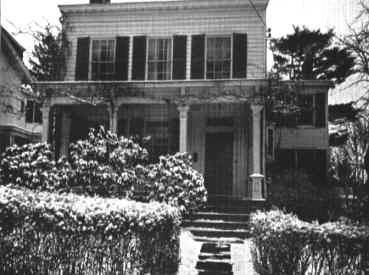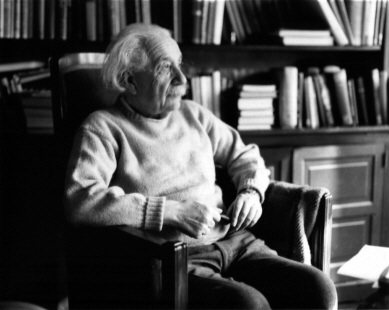“I am very happy in my new home in this friendly country and the liberal atmosphere of Princeton.”
Albert Einstein, 1935
ALBERT EINSTEIN’S YEARS IN PRINCETON (USA)
From 1902–1909 Einstein spent successful years in Bern. After that time he stayed in Zurich and in Prague for a short time, returned to Zurich and from then on worked as professor at the Prussian Academy of Science in Berlin from 1914–1932. Due to political reasons he had to emigrate in 1933. He found his last workplace in Princeton (New Jersey), a magnificent little town 100 km south of New York.
Already at the end of 1930 did Einstein receive the permission of the Prussian Ministry of Education and the Arts to lecture in the winter month for one guest semester. He did this every year until his emigration so that he lived in Princeton in the winter month and in Berlin in the summer month. American scientists made great efforts in the 1920ies to send their famous European colleagues to the USA. This tendency even increased due to the events of 1933. Thus they wanted to support the development of science and technology in the USA more than ever. Abraham Flexner, the founder of the “Institute for Advanced Study” in Princeton had in 1932 received Einstein’s promise, to participate in this institution which resembled the Kaiser Wilhelm Institutes in Berlin. The financial means were guaranteed by a foundation. Einstein should have the possibility to solely devote himself to his research, like he did in Berlin, and not have any firm lecturing hours.
At the end of 1932 the Einstein’s, Albert and his second wife Elsa, took their preparations for their third journey to America. In the meantime the anti-Semitic campaign against Einstein in Germany increased. In America there was also a wave of protest against him because of his actions for pacifism. Albert and Elsa arrived in California at the beginning of January in 1933. First they went to Pasadena and later followed their first longer stay in Princeton. In the Mount Wilson Observatory he debated the mysteries of universe with Edwin Hubble, the discoverer of the big bang.
In the middle of March 1933 Einstein decided to return to Europe. Already during the way home on board of the ship “Belgenland” they heard further alarming news from Germany. Einstein wrote his resignation to the Berlin Academy already during his crossing to Europe. After his arrival in Antwerpen, Einstein decided not to return to Germany and to never again enter German ground. He spent some time in Belgium and England.
In autumn it was finally decided to leave Europe and to emigrate to the United States. On October 7 in 1933 Einstein and his wife Elsa, his secretary Helen Dukas and his assistant Dr. Walther Mayer, travelled from Southampton to the USA with the steamship “Westernland” (Red Star Line).
A new beginning in Princeton (USA)
After the arrival in New York – while the reception was no longer as tumultuous as in previous years – Einstein and his company were taken to Princeton with the car. Later his stepdaughter Margot, Hans Albert, Einstein’s older son from his first marriage and Einstein’s sister Maja also followed the emigrants. It was a new beginning for all of them.
Einstein’s new workplace was the “Institute for Advanced Study” which he stayed loyal to until his death in 1955. This institute had back then a good reputation all over the world. As Jewish scientists were driven out of the country after the national socialists seized power, the leadership of physics, the “science of fate of the 20th century” changed over from Germany to the United States. Through Albert Einstein, the “pope of physics” the “Institute for Advanced Study” became in the following years the most famous research centre of the world. Einstein liked the working conditions at the institute. In the morning he could be met at the institute most of the time. In the afternoon he liked being at home, meeting friends and famous persons from science and politics. He recovered while doing long walks in the park.
In August 1935 Einstein bought a single family house at 112 Mercer Street in Princeton, near the institute, in which he lived with his wife Elsa, his stepdaughter Margot and his secretary Helen Dukas. Unfortunately his wife fell ill a short time later and died in December 1936. He had to face another death only a short time after that when his former fellow student Marcel Grossmann died. There was so much to thank him for.

In December 1936 the 150 years celebration of the “Naturforschende Gesellschaft Bern” took place in the assembly hall of the university of Bern. On this occasion Albert Einstein was made a honorary member for his work. After having received the certificate of honour, Einstein was very pleased and gave it a place of honour in the flat in Princeton. His beloved violin, with which he also liked to play Mozart or Bach even in far-away countries, belonged to his most important souvenirs of his time in Switzerland. The little Swiss military service book, which nowadays is kept in the Einstein archive in Jerusalem, counted to the few documents he took with him.
At the “Institute for Advanced Study” the great Einstein was given the best research possibilities. No pressure was exerted on him to do research. This fact permitted his further work on his theory of gravity with the aim to enlarge it to a “Unified field theory”. Besides, he continued to take care of pacifistic and Zionistic organizations and, with the help of friends and colleagues, supported the steadily growing number of emigrants.
University and institute
It must also be mentioned that Princeton, near the capital Trenton in the State of New Jersey, also has an excellent university besides the “Institute for Advanced Study”, at which, however, mainly young people from well-off families are given the possibility to study. The Princeton University, at which Einstein held lectures, too, is among the most famous universities of the United States. A striking number of Nobel laureates of recent years have studied at this private university, especially physicists and mathematicians. The buildings of the university, which are located about 3 km away from the institute, are situated in an English garden. The time-honoured architecture resembles the ones of the universities of Oxford and Cambridge. The university and the institute conveys a bit of the style of living and working, of the special character of these places of research: the mixture of British country house and American way of life.
The last years of his life
In October 1940 Einstein became an American citizen. But he also kept the Swiss citizenship which he had been given in Zurich in 1901. He communicated again and again with his former colleagues and friends. Thus he wrote, among other things, in 1949 to his friend and former working colleague from the Patent Office Michele Besso: “The best that remains are a few honest friends who have head and heart in the right place and understand each other like we do.” Also in later years Einstein was stricken with homesickness after the cosy Kramgasse in Bern and wrote: “Yes, it was a nice time back then in Bern.”

At the beginning of the 1950ies Einstein developed health problems. Despite that fact he constantly worked on his field theory, but his efforts were not successful.
After short illness Albert Einstein died on April 18, 1955 at the age of 76. He had been politically active until his last days. As he hated personality cult, he prohibited any funeral service. Only his closest relatives and friends bode him farewell in the crematory.
Dr. Adolf Meichle
The author has been member of the board of executive directors of the Albert Einstein-Gesellschaft (Albert Einstein Society) in Bern for years. He is bearer of the Einstein Medal which is awarded by the Albert Einstein Society every year to persons who have rendered outstanding services through their work in connection with Albert Einstein.
Illustrations Credits:
Courtesy of the Albert Einstein Society, Bern: 1, 2


 DEUTSCH
DEUTSCH